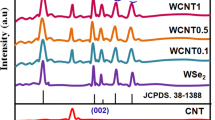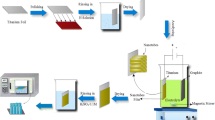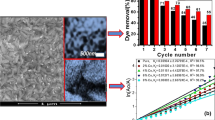Abstract
Three-atom-thick two-dimensional layered transition metal dichalcogenides (TMDs) has shown appreciable capabilities as materials candidate for photocatalytic applications. In particular, atomically-thin tungsten disulfide (WS2) has shown attractive interest towards visible-light photocatalytic activity. In this work, we show that the atomically-thin WS2 films can be used as an effective photocatalyst with Methylene Blue (MB) as a model pollutant, under visible light irradiation. Further, we demonstrate that these WS2 thin film samples can be recovered effortlessly without losing its chemical and structural stability. The bi-layered WS2 films yielded a degradation efficiency of ~94% for MB dye. Recovery and reusability of the WS2 thin films were demonstrated without significant loss in the degradation-efficiency even after 4-cycles of degradation. This study may pave the way for the large-scale degradation and recycling of various effluents using recoverable thin-film photocatalysts.












Similar content being viewed by others
Data availability
All the data that support the findings of this study are included within the article (and any supplementary files).
References
J. Di, J. Xia, H. Li, Z. Liu, Freestanding atomically-thin two-dimensional materials beyond graphene meeting photocatalysis: opportunities and challenges. Nano Energy 35, 79–91 (2017). https://doi.org/10.1016/j.checat.2021.01.002
Y. Liu, H. Wang, X. Yuan, Y. Wu, H. Wang, Y. Tan et al., Roles of sulfur-edge sites, metal-edge sites, terrace sites, and defects in metal sulfides for photocatalysis. Chem Catal. 1(1), 44–68 (2021). https://doi.org/10.1016/j.checat.2021.01.002
P. Senthil Kumar, M. Selvakumar, S. Babu, S. Jaganathan, S. Karuthapandian, S. Chattopadhyay, Novel CuO/chitosan nanocomposite thin film: facile hand-picking recoverable, efficient and reusable heterogeneous photocatalyst. RSC Adv. 5(71), 57493–57501 (2015). https://doi.org/10.1039/c5ra08783j
W. Ashraf, T. Fatima, K. Srivastava, M. Khanuja, Superior photocatalytic activity of tungsten disulfide nanostructures: role of morphology and defects. Appl. Nanosci. 9(7), 1515–1529 (2019). https://doi.org/10.1007/s13204-019-00951-4
T. de Oliveira Guidolin, N. Possolli, M. Polla, T. Wermuth, T. de Franco Oliveira, S. Eller et al., Photocatalytic pathway on the degradation of methylene blue from aqueous solutions using magnetite nanoparticles. J. Clean. Prod. 318, 128556 (2021). https://doi.org/10.1016/j.jclepro.2021.128556
J. Shi, D. Ma, G. Han, Y. Zhang, Q. Ji, T. Gao et al., Controllable growth and transfer of monolayer MoS2 on au foils and its potential application in hydrogen evolution reaction. ACS Nano 8(10), 10196–10204 (2014). https://doi.org/10.1021/nn503211t
A. Sindhu, N. Shinde, S. Harish, M. Navaneethan, S. Eswaran, Recoverable and reusable visible-light photocatalytic performance of CVD grown atomically thin MoS2 films. Chemosphere 287, 132347 (2022). https://doi.org/10.1016/j.chemosphere.2021.132347
M. Sabarinathan, S. Harish, J. Archana, M. Navaneethan, H. Ikeda, Y. Hayakawa, Controlled exfoliation of monodispersed MoS2 layered nanostructures by a ligand-assisted hydrothermal approach for the realization of ultrafast degradation of an organic pollutant. RSC Adv. 6(111), 109495–109505 (2016). https://doi.org/10.1039/c6ra24355j
M. Sabarinathan, S. Harish, J. Archana, M. Navaneethan, H. Ikeda, Y. Hayakawa, Highly efficient visible-light photocatalytic activity of MoS2–TiO2 mixtures hybrid photocatalyst and functional properties. RSC Adv. 7(40), 24754–24763 (2017). https://doi.org/10.1039/c7ra03633g
R. Abinaya, J. Archana, S. Harish, M. Navaneethan, S. Ponnusamy, C. Muthamizhchelvan et al., Ultrathin layered MoS2 nanosheets with rich active sites for enhanced visible light photocatalytic activity. RSC Adv. 8(47), 26664–26675 (2018). https://doi.org/10.1039/c8ra02560f
M. Patel, M. Patel, C. Sumesh, Visible light enhanced photocatalytic performance of WS2 catalyst for the degradation of ternary dye mixture. AIP Conf. Proc. (2020). https://doi.org/10.1063/5.0001154
M. Chhowalla, H. Shin, G. Eda, L. Li, K. Loh, H. Zhang, The chemistry of two-dimensional layered transition metal dichalcogenide nanosheets. Nat. Chem. 5(4), 263–275 (2013). https://doi.org/10.1038/nchem.1589
A. Chernikov, T. Berkelbach, H. Hill, A. Rigosi, Y. Li, B. Aslan et al., Exciton binding energy and nonhydrogenic rydberg series in monolayer WS2. Phys. Rev. Lett. (2014). https://doi.org/10.1103/PhysRevLett.113.076802
A. Katz, M. Redlich, L. Rapoport, H. Wagner, R. Tenne, Self-lubricating coatings containing fullerene-like WS2 nanoparticles for orthodontic wires and other possible medical applications. Tribol. Lett. 21(2), 135–139 (2006). https://doi.org/10.1007/s11249-006-9029-4
T. Georgiou, R. Jalil, B. Belle, L. Britnell, R. Gorbachev, S. Morozov et al., Vertical field-effect transistor based on graphene–WS2 heterostructures for flexible and transparent electronics. Nat. Nanotechnol. 8(2), 100–103 (2012). https://doi.org/10.1038/nnano.2012.224
N. Huo, S. Yang, Z. Wei, S. Li, J. Xia, J. Li, Photoresponsive and gas sensing field-effect transistors based on multilayer WS2 nanoflakes. Sci. Rep. (2014). https://doi.org/10.1038/srep05209
G. Navale, C. Rout, K. Gohil, M. Dharne, D. Late, S. Shinde, Oxidative and membrane stress-mediated antibacterial activity of WS2and rGO-WS2 nanosheets. RSC Adv. 5(91), 74726–74733 (2015). https://doi.org/10.1039/c5ra15652a
X. Zong, J. Han, G. Ma, H. Yan, G. Wu, C. Li, Photocatalytic H2 evolution on CdS loaded with WS2 as cocatalyst under visible light irradiation. J. Phys. Chem. C 115(24), 12202–12208 (2011). https://doi.org/10.1021/jp2006777
C. Rout, P. Joshi, R. Kashid, D. Joag, M. More, A. Simbeck et al., Superior field emission properties of layered WS2-RGO nanocomposites. Sci. Rep. (2013). https://doi.org/10.1038/srep03282
Y. Sun, S. Gao, F. Lei, C. Xiao, Y. Xie, Ultrathin two-dimensional inorganic materials: new opportunities for solid state nanochemistry. Acc. Chem. Res. 48(1), 3–12 (2014). https://doi.org/10.1021/ar500164g
A. Arora, M. Koperski, K. Nogajewski, J. Marcus, C. Faugeras, M. Potemski, Excitonic resonances in thin films of WSe2: from monolayer to bulk material. Nanoscale 7(23), 10421–10429 (2015). https://doi.org/10.1039/c5nr01536g
T. Cheiwchanchamnangij, W. Lambrecht, Quasiparticle band structure calculation of monolayer, bilayer, and bulk MoS2. Phys. Rev. B (2012). https://doi.org/10.1103/physrevb.85.205302
X. Zhang, Y. Xie, Recent advances in free-standing two-dimensional crystals with atomic thickness: design, assembly and transfer strategies. Chem. Soc. Rev. 42(21), 8187 (2013). https://doi.org/10.1039/C3CS60138B
S. Vattikuti, C. Byon, C. Reddy, Preparation and improved photocatalytic activity of mesoporous WS 2 using combined hydrothermal-evaporation induced self-assembly method. Mater. Res. Bull. 75, 193–203 (2016). https://doi.org/10.1016/j.materresbull.2015.11.059
H. Sade, J. Lellouche, Preparation and characterization of WS2@SiO2 and WS2@PANI core-shell nanocomposites. Nanomaterials 8(3), 156 (2018). https://doi.org/10.3390/nano8030156
A. Fernández, G. Lassaletta, V. Jiménez, A. Justo, A. González-Elipe, J. Herrmann et al., Preparation and characterization of TiO2 photocatalysts supported on various rigid supports (glass, quartz and stainless steel). Comparative studies of photocatalytic activity in water purification. Appl. Catal. B Environ. 7(1–2), 49–63 (1995). https://doi.org/10.1016/0926-3373(95)00026-7
A. Munshi, M. Shi, S. Thomas, M. Saunders, M. Spackman, K. Iyer et al., Magnetically recoverable Fe3O4@Au-coated nanoscale catalysts for the A3-coupling reaction. Dalton Trans. 46(16), 5133–5137 (2017). https://doi.org/10.1039/C7DT00058H
D.J. Cole-Hamilton, Homogeneous catalysis—New approaches to catalyst separation, recovery, and recycling. Science 299(5613), 1702–1706 (2003). https://doi.org/10.1126/science.1081881
R. Chianelli, The reactivity of MoS2 single crystal edge planes. J. Catal. 92(1), 56–63 (1985). https://doi.org/10.1016/0021-9517(85)90236-2
M. Daage, R. Chianelli, Structure-function relations in molybdenum sulfide catalysts: The “Rim-Edge” model. J. Catal. 149(2), 414–427 (1994). https://doi.org/10.1006/jcat.1994.1308
N. Dhas, A. Ekhtiarzadeh, K. Suslick, Sonochemical preparation of supported hydrodesulfurization catalysts. J. Am. Chem. Soc. 123(34), 8310–8316 (2001). https://doi.org/10.1021/ja010516y
S. Vattikuti, C. Byon, V. Chitturi, Selective hydrothermally synthesis of hexagonal WS2 platelets and their photocatalytic performance under visible light irradiation. Superlatt. Microstruct. 94, 39–50 (2016). https://doi.org/10.1016/j.spmi.2016.03.042
V. Murugan, K. Meganathan, N. Shinde, S. Eswaran, Strain-mediated unusual bandgap bowing in continuous composition tuned monolayer Mo1−xWxS2 ternary alloys. Appl. Phys. Lett. 118(1), 013102 (2021). https://doi.org/10.1063/5.0022790
N. Shinde, B. Ryu, K. Meganathan, B. Francis, C. Hong, S. Chandramohan et al., Large-scale atomically thin monolayer 2H-MoS2 field-effect transistors. ACS Appl. Nano Mater. 3(8), 7371–7376 (2020). https://doi.org/10.1021/acsanm.0c01235
N. Shinde, B. Francis, M. Ramachandra Rao, B. Ryu, S. Chandramohan, S. Eswaran, Rapid wafer-scale fabrication with layer-by-layer thickness control of atomically thin MoS2 films using gas-phase chemical vapor deposition. APL Mater. 7(8), 081113 (2019). https://doi.org/10.1063/1.5095451
L. Liu, B. Zhang, Y. Zhang, Y. He, L. Huang, S. Tan et al., Simultaneous removal of cationic and anionic dyes from environmental water using montmorillonite-pillared graphene oxide. J. Chem. Eng. Data 60(5), 1270–1278 (2015). https://doi.org/10.1021/je5009312
H. Zeng, G. Liu, J. Dai, Y. Yan, B. Zhu, R. He et al., Optical signature of symmetry variations and spin-valley coupling in atomically thin tungsten dichalcogenides. Sci. Rep. (2013). https://doi.org/10.1038/srep01608
N. Babu Shinde, B. Deul Ryu, C. Hong, B. Francis, S. Chandramohan, E.S. Kumar, Growth Behavior, nucleation control and excellent optical properties of atomically thin WS2 thin films processed via Gas-phase chemical vapor deposition. Appl. Surf. Sci. 568, 150908 (2021). https://doi.org/10.1016/j.apsusc.2021.150908
J. Park, W. Lee, T. Choi, S. Hwang, J. Myoung, J. Jung et al., Layer-modulated synthesis of uniform tungsten disulfide nanosheet using gas-phase precursors. Nanoscale 7(4), 1308–1313 (2015). https://doi.org/10.1039/C4NR04292A
A. Berkdemir, H. Gutiérrez, A. Botello-Méndez, N. Perea-López, A. Elías, C. Chia et al., Identification of individual and few layers of WS2 using Raman spectroscopy. Sci. Rep. (2013). https://doi.org/10.1038/srep01755
R. Jha, P. Guha, An effective liquid-phase exfoliation approach to fabricate tungsten disulfide into ultrathin two-dimensional semiconducting nanosheets. J. Mater. Sci. 52(12), 7256–7268 (2017). https://doi.org/10.1007/s10853-017-0962-4
A. Pawbake, R. Waykar, D. Late, S. Jadkar, Highly transparent wafer-scale synthesis of crystalline WS2 nanoparticle thin film for photodetector and humidity-sensing applications. ACS Appl. Mater. Interfaces 8(5), 3359–3365 (2016). https://doi.org/10.1021/acsami.5b11325
H. Gutiérrez, N. Perea-López, A. Elías, A. Berkdemir, B. Wang, R. Lv et al., Extraordinary room-temperature photoluminescence in triangular WS2 monolayers. Nano Lett. 13(8), 3447–3454 (2012). https://doi.org/10.1021/nl3026357
P. Liu, T. Luo, J. Xing, H. Xu, H. Hao, H. Liu et al., Large-area WS2 film with big single domains grown by chemical vapor deposition. Nanoscale Res. Lett. (2017). https://doi.org/10.1186/s11671-017-2329-9
P. Liu, J. Zhang, D. Gao, W. Ye, Efficient visible light-induced degradation of rhodamine B by W(NxS1−x)2 nanoflowers. Sci. Rep. (2017). https://doi.org/10.1038/srep40784
H. Mittal, M. Khanuja, Nanosheets- and nanourchins-like nanostructures of MoSe2 for photocatalytic water purification: kinetics and reusability study. Environ. Sci. Pollut. Res. 27(19), 23477–23489 (2019). https://doi.org/10.1007/s11356-019-06275-8
Y. Wu, M. Su, J. Chen, Z. Xu, J. Tang, X. Chang et al., Superior adsorption of methyl orange by h-MoS2 microspheres: isotherm, kinetics, and thermodynamic studies. Dyes Pigm. 170, 107591 (2019). https://doi.org/10.1016/j.dyepig.2019.107591
L. Ai, C. Zhang, L. Meng, Adsorption of methyl orange from aqueous solution on hydrothermal synthesized Mg–Al layered double hydroxide. J. Chem. Eng. Data 56(11), 4217–4225 (2011). https://doi.org/10.1021/je200743u
S. Harish, M. Navaneethan, J. Archana, A. Silambarasan, S. Ponnusamy, C. Muthamizhchelvan et al., Controlled synthesis of organic ligand passivated ZnO nanostructures and their photocatalytic activity under visible light irradiation. Dalton Trans. 44(22), 10490–10498 (2015). https://doi.org/10.1039/C5DT01572C
Q. Zhang, Y. Zhang, Z. Meng, W. Tong, X. Yu, Q. An, Constructing the magnetic bifunctional graphene/Titania nanosheet-based composite photocatalysts for enhanced visible-light photodegradation of MB and electrochemical ORR from polluted water. Sci. Rep. (2017). https://doi.org/10.1038/s41598-017-12504-2
D. Thakur, M. Sharma, R. Vaish, V. Balakrishnan, WS2 monolayer for piezo-phototronic dye degradation and bacterial disinfection. ACS Appl. Nano Mater. 4(8), 7879–7887 (2021). https://doi.org/10.1021/acsanm.1c01202
P. Bakre, P. Volvoikar, A. Vernekar, S. Tilve, Influence of acid chain length on the properties of TiO2 prepared by sol-gel method and LC-MS studies of methylene blue photodegradation. J. Colloid Interface Sci. 474, 58–67 (2016). https://doi.org/10.1016/j.jcis.2016.04.011
V. Mrunal, A. Vishnu, N. Momin, J. Manjanna, Cu2O nanoparticles for adsorption and photocatalytic degradation of methylene blue dye from aqueous medium. Environ. Nanotechnol. Monitoring Manag. 12, 100265 (2019). https://doi.org/10.1016/j.enmm.2019.100265
Q. Shang, T. Zeng, K. Gao, N. Liu, Q. Cheng, G. Liao et al., A novel nitrogen heterocyclic ligand-based MOF: synthesis, characterization and photocatalytic properties. New J. Chem. 43(42), 16595–16603 (2019). https://doi.org/10.1039/C9NJ04371C
Acknowledgements
We are grateful to Science and Engineering Research Board (SERB), Department of Science and Technology, India for the financial support (Grant No. ECR/2016/000918 & CRG/2023/2938). We sincerely acknowledge SRMIST for the seed grant and startup grant for the establishment of MicroRaman spectrometer and UV-Vis-NIR spectrometer. We acknowledge Nanotechnology Research Center for providing support of characterization facilities.
Funding
Funding was supported by Science and Engineering Research Board, No: ECR/2016/000918, CRG/2023/2938.
Author information
Authors and Affiliations
Contributions
ASS, KM, SH, MN and SKE have conceived and designed the research work. ASS and KM have contributed to the implementation of the idea. All the authors have contributed to data analysis and writing of the manuscript.
Corresponding author
Ethics declarations
Conflict of interest
The authors declare that they have no conflict of interest.
Additional information
Publisher's Note
Springer Nature remains neutral with regard to jurisdictional claims in published maps and institutional affiliations.
Supplementary Information
Below is the link to the electronic supplementary material.
Rights and permissions
Springer Nature or its licensor (e.g. a society or other partner) holds exclusive rights to this article under a publishing agreement with the author(s) or other rightsholder(s); author self-archiving of the accepted manuscript version of this article is solely governed by the terms of such publishing agreement and applicable law.
About this article
Cite this article
Sindhu, A.S., Meganathan, K., Harish, S. et al. Seamless recovery and reusable photocatalytic activity of CVD grown atomically-thin WS2 films. J Mater Sci: Mater Electron 35, 877 (2024). https://doi.org/10.1007/s10854-024-12615-3
Received:
Accepted:
Published:
DOI: https://doi.org/10.1007/s10854-024-12615-3




